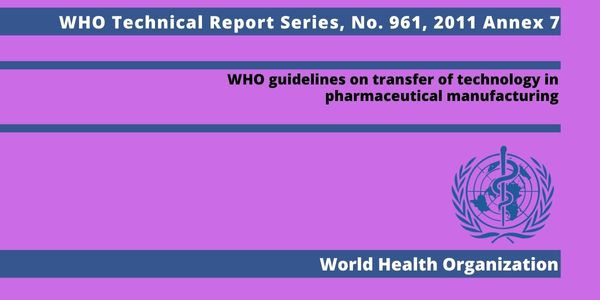WHO guidelines on transfer of technology in pharmaceutical manufacturing
1. Introduction:
These guiding principles on transfer of technology are intended to serve as a framework which can be applied in a flexible manner rather than as strict rigid guidance. Focus has been placed on the quality aspects, in line with WHO’s mandate.
1.1 Transfer of processes to an alternative site occurs at some stage in the life-cycle of most products, from development, scale-up, manufacturing, production and launch, to the post-approval phase.
1.2 Transfer of technology is defined as “a logical procedure that controls the transfer of any process together with its documentation and professional expertise between development and manufacture or between manufacture sites”. It is a systematic procedure that is followed in order to pass the documented knowledge and experience gained during development and or commercialization to an appropriate, responsible and authorized party. Technology transfer embodies both the transfer of documentation and the demonstrated ability of the receiving unit (RU) to effectively perform the critical elements of the transferred technology, to the satisfaction of all parties and any applicable regulatory bodies.
1.3 Literature searches revealed little information on the subject originating from national or regional regulatory bodies. Guidance on intracompany transfers was prepared by the International Society for Pharmaceutical Engineering (ISPE) (1).
1.4 The ever changing business strategies of pharmaceutical companies increasingly involve intra- and intercompany transfers of technology for reasons such as the need for additional capacity, relocation of operations or consolidations and mergers. The WHO Expert Committee on Specifications for Pharmaceutical Preparations, therefore, recommended in its forty second report that WHO address this issue through preparation of WHO guidelines on this matter (2).
1.5 Transfer of technology requires a documented, planned approach using trained and knowledgeable personnel working within a quality system, with documentation of data covering all aspects of development, production and quality control. Usually there is a sending unit (SU), a receiving unit and the unit managing the process, which may or may not be a separate entity. For “contract manufacturing” please see good manufacturing practices (GMP) (3).
Click on the following title for full details: pdf
Table of contents
4. Organization and management
5. Production: transfer (processing, packaging and cleaning)
6. Quality control: analytical method transfer
9. Qualification and validation



